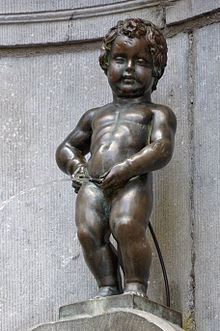Sculpture in Brussels

Sculpture in Brussels is sculpture that has been created in Brussels, Belgium, since the Middle Ages to the present day.[1] It began to shine in the second half of the 14th century with Claus Sluter's arrival in Brussels and the construction of Brussels' Town Hall. It continued without interruption and reached its momentum during 15th and 16th centuries. Until the end of the Ancien Régime, sculptors in Brussels were members of the Quatre Couronnés Guild of the Nation of St Nicholas and then the Royal Academy of Fine Arts.
History[edit]
Brussels' sculpture began to assert itself in the second half of the 14th century with the arrival of the Dutch sculptor Claus Sluter, who was probably trained in Brussels,[a] and who lived there from 1380 to 1385, before settling in Dijon, France. The art reached its momentum during the 15th and 16th centuries thanks to uninterrupted corporate training.[1]
Around 1500, the most notable sculptors of altarpieces were the Borreman(s) (notably: Jan Borreman the Elder and the Younger, and Passchier Borreman). Among the sculptors who benefited most from the cultural policy of the Archdukes Albert VII and Isabella were the Antwerp-born Robrecht Colyns de Nole and the Brussels-born Jérôme Duquesnoy the Elder (best known for his Manneken Pis).
Until the end of the Ancien Régime, the training of sculptors in Brussels took place mainly within the framework of the Quatre Couronnés Guild of the Nation of St Nicholas, and was later taken up by the Royal Academy of Fine Arts. Brussels, alongside Mechelen and Antwerp, played a dynamic role in the field of sculpture in the former Southern Netherlands.[3][4] The archives bear witness to the existence of numerous active workshops training apprentices. The sculptors of Leuven were also influenced by those of Brussels.[5]
Sculptors[edit]
Among the sculptors born in Brussels or who were active there, one can mention: Jan Borreman (fl. 1479–1520), Jérôme Duquesnoy (I) (1570?–1641?), François Duquesnoy (1597–1643), Jerôme Duquesnoy (II) (baptised 1602–1654), Jan van Delen (1635/1636–1703), Jan Cosijn (1646–1708), Cornelis van Nerven (c. 1660–1715), Marc de Vos (1650–1717), Peter van Dievoet (1661–1729), Jan de Kinder (1675–1739), Pierre-Denis Plumier (1688–1721), Jacques Bergé (1693–1756), François Lejeune (1721–1790), Jean-Baptiste Fleuriot-Lescot (1761–1794, guillotined), and Gilles-Lambert Godecharle (1750−1835).
Gallery[edit]
-
The White Lamb, by Peter van Dievoet, Maison de l'Agneau Blanc, Rue du Marché aux Herbes/Grasmarkt, 1696
-
Romulus and Remus being suckled by the she-wolf, by Marc de Vos, La Louve (Den Wolf or Den Wolvin) guildhall, Grand-Place/Grote Markt, 1696
-
The Scheldt, by Pierre-Denis Plumier, courtyard of Brussels' Town Hall, 1715
-
Justice punishing Vices and rewarding Virtues, by Gilles-Lambert Godecharle, pediment of the Palace of the Nation, Rue de la Loi/Wetstraat, 1781–82
See also[edit]
References[edit]
Footnotes[edit]
Citations[edit]
- ^ a b Le Folklore brabançon (in French), 1976, p. 103 : "Ces chefs-d'œuvre appartiennent tous deux, à la sculpture bruxelloise, très florissante aux xveet xvie siècles".
- ^ Morand, Kathleen (1991). Claus Sluter: Artist at the Court of Burgundy. Austin, Texas: University of Texas Press. p. 24.
- ^ Denis Coekelberghs, Report on the exhibition Les sculpteurs malinois en Europe (1780-1850) (in French), Mechelen, Lamot and Museum Schepenhuis, 17 February to 23 April 2006 : "Un des principaux constats mis en évidence dans cet ouvrage concerne le rôle particulièrement dynamique joué par les artistes issus du duché de Brabant et de ses principales villes que sont Bruxelles, Anvers et Malines, à côté de cet autre centre artistique de premier ordre qu’était la principauté de Liège".
- ^ Pierre-Yves Le Pogam, Sculpture à la lettre: promenade épigraphique au département des Sculptures du musée du Louvre (in French), Officina Libraria, 2008, p. 134 : "Dans les anciens Pays-Bas du Sud, les trois grandes villes du Brabant spécialisées dans la création en série de sculptures, Malines, Anvers et Bruxelles, utilisaient chacune des marques pour distinguer leur production et garantir la qualité".
- ^ Dominique Hollanders-Favart, Roger Van Schoute, Le Dessin sous-jacent dans la peinture: Colloque III, 6-7-8 September 1979 : le problème Maître de Flémalle-van der Weyden (in French), College Erasme, 1981, p. 17 : "une grande vogue dans la sculpture bruxelloise et dans celle des centres secondaires qui en dérivent, comme c'est le cas de Louvain".
Bibliography[edit]
Printed books[edit]
- Messager des sciences historiques, des arts et de la bibliographie de Belgique, Ghent, 1854: "Archives des Arts, des Sciences et des lettres, sculpteurs et sculptures, Noms des sculpteurs qui ont fait partie du métier des Quatre-Couronnés à Bruxelles, depuis 1621 à 1716". read online
- Guillaume Des Marez, L'architecte Jean Van Ruysbroeck et le xve siècle Bruxellois, Brussels, 1923.
- J. Duverger, De Brusselsche steenbickeleren, beeldhouwers, bouwmeesters, metselaars enz. der xive en xve eeuw, Ghent, 1933.
- Annales de la Société royale d'archéologie de Bruxelles
- Brigitte D’Hainaut-Zveny, Miroirs du sacré. Les retables sculptés à Bruxelles. xve-xvie centuries, CFC-Éditions, Brussels, 2005, (ISBN 2-930018-55-0).
Manuscripts[edit]
- Notice des peintres, sculpteurs, architectes et graveurs, natifs de Bruxelles, avec la liste de leurs principaux ouvrages. Manuscript in-folio of 223 pages, from the library of Georges-Joseph Gérard, obtained by the government of The Netherlands and transposed at The Hague.





